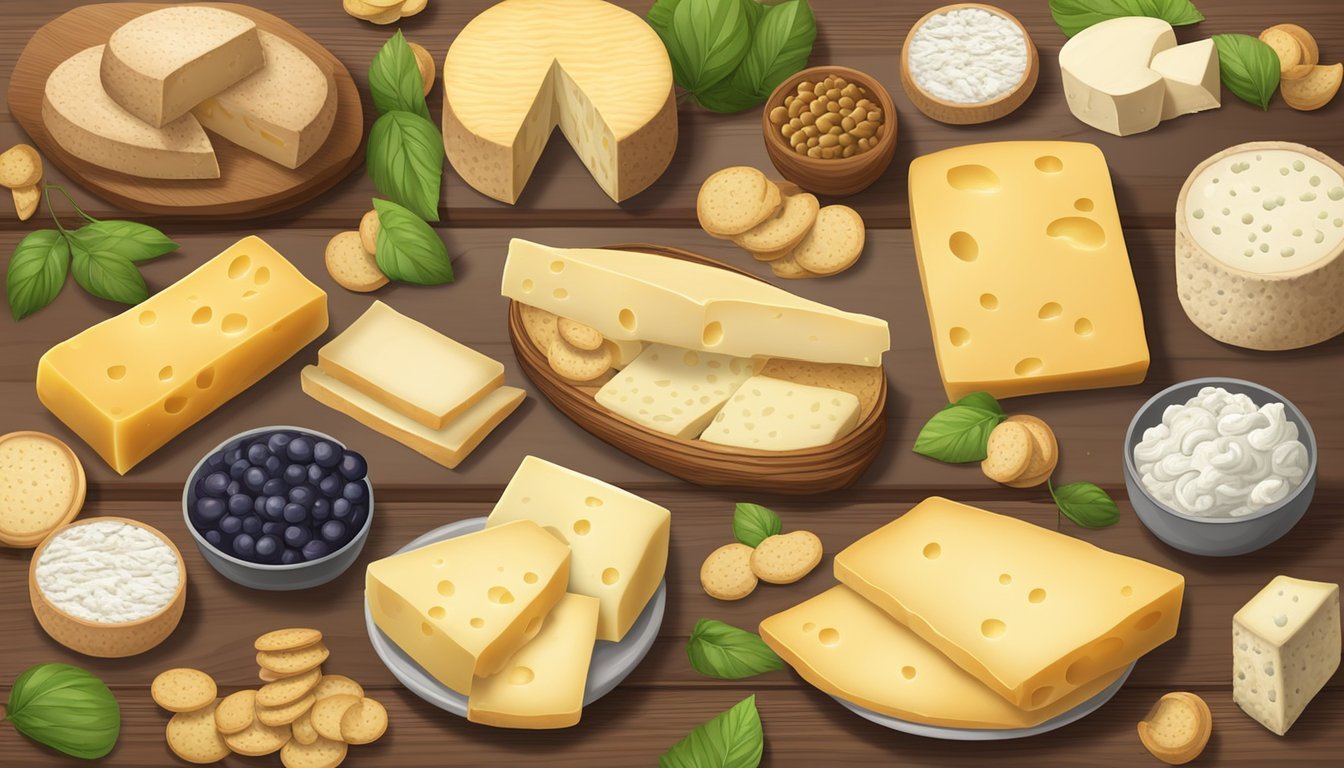Asiago Cheese Substitutes
Top Alternatives for Your Recipes
Asiago cheese (What wine goes well with cheese?), a popular Italian cheese known for its rich flavor and versatility, is often used in various dishes, from pastas to salads to soups. It comes in different textures, ranging from smooth and creamy to crumbly and sharp, depending on the aging process. Fresh Asiago, known as Asiago Pressato, has a milder, buttery flavor and melts easily, while aged Asiago, or Asiago d’Allevo, develops a more pronounced nuttiness and is great for grating.
For chefs and home cooks looking to capture a similar taste or texture profile without Asiago cheese, a range of substitutes can offer satisfactory results. Substitutes such as Manchego, Provolone, or Pecorino Romano not only mimic the taste and feel of Asiago to various extents but can also add their own distinctive twist to a dish. Manchego cheese, hailing from Spain, shares the dual soft and hard forms like Asiago, while Provolone offers a more accessible option with its sweet and spicy variants, and Pecorino Romano brings a bold, salty flavor from its sheep’s milk origin.
Using these alternatives can be particularly helpful when Asiago cheese is not readily available, or when one desires a different flavor note in their culinary creations. They are widely appreciated for their ability to blend well with a multitude of recipes, providing cooks and food enthusiasts with the flexibility to explore different taste dimensions in classic and novel dishes alike.
Understanding Asiago Cheese
Asiago Cheese, originating from Italy, is renowned for its versatility in culinary applications and its distinct flavor profile. This section will explore its origins, unique characteristics, and uses in various dishes.
Origins and Tradition
Asiago cheese hails from the Asiago Plateau in the Veneto region of Northern Italy. It has a rich tradition dating back centuries and is a product imbued with a sense of place and heritage. The Protected Designation of Origin (PDO) status assures its quality and maintains traditional production methods. This label ensures that only cheese produced in this specific area can be called Asiago, preserving its link to its geographical origin.
Flavor and Texture Profile
The flavor and texture of Asiago cheese can vary significantly depending on its aging. Fresh Asiago (Asiago Pressato) has a smooth, semi-hard texture and a mild, buttery flavor. In contrast, aged Asiago (Asiago d'Allevo) has a hard texture that can range from medium-hard to very hard, grainy, and crumbly as it matures. Its flavor develops into a rich and nutty profile that becomes more pronounced with age.
Age of Asiago Texture Flavor Fresh Semi-hard, buttery Mild, milky Aged Hard, grainy, crumbly Rich, nutty, sharp
Culinary Uses
Asiago cheese's versatility allows it to be used in a wide array of recipes and dishes. It is commonly:
Grated over pasta dishes, salads, and soups
Integrated into sauces and risotto
Included in sandwiches for its melting qualities
Featured on a cheese board
Used as a pizza topping
Whether incorporated into dishes or enjoyed on its own, Asiago adds a distinctive Italian flavor that is cherished in cuisines worldwide.
Asiago Cheese Substitutes
Asiago cheese is known for its versatile nature in recipes, ranging from melting smoothly in hot dishes to being used as a flavorful topping when grated. Finding the right substitute involves considering the desired texture and flavor profile, whether it's a hard cheese for grating or a milder cheese for a smooth melt.
Cheese Substitutes Overview
There is a range of substitutes that can replace Asiago cheese, each offering a distinct flavor and texture. Hard cheeses are typically best for recipes that call for grated Asiago, while softer varieties suit dishes requiring a smooth melt.
Hard Cheese Alternatives
Grana Padano and Pecorino Romano are Italian hard cheeses known for their granular textures and savory flavors, making them excellent substitutes for grating over pasta and salads. Grana Padano is milder and less salty than Parmesan, while Pecorino Romano made from sheep's milk, provides a tangier taste. Dry Jack, an American cheese, also offers a hard texture and is suitable for grating.
Options for Hard Cheese Alternatives:
Grana Padano
Pecorino Romano
Parmigiano-Reggiano
Dry Jack
Romano
Mild and Buttery Substitutes
If a recipe needs the creamy, buttery essence of younger Asiago cheese, Provolone and Gouda are excellent alternatives. Provolone has a smooth taste with sweet or spicy variations, and Gouda has a mild, rich flavor that works well in melting applications. Monterey Jack, with its buttery and mild character, is another fitting choice.
Mild and Buttery Cheese Options:
Provolone Cheese (sweet: Provolone Dolce, spicy: Provolone Piccante)
Gouda Cheese
Monterey Jack Cheese
Unique Substitutes
For a unique twist, Manchego, a Spanish cheese, provides a nutty flavor and comes in soft and hard varieties similar to Asiago. It is one of the most accurate substitutes, especially when using a medium-aged version which can be substituted 1:1. Cheddar can sometimes be used, though it has a sharper flavor.
Unique Cheese Alternatives:
Manchego Cheese (medium-aged)
Cheddar Cheese (mild)
Cheese Characteristics and Pairings
Choosing the right Asiago cheese substitute involves understanding the characteristics of cheese, such as aging and texture, and how it combines with other flavors in dishes.
Aging and Texture Considerations
As Asiago cheese ages, it develops from semi-hard Asiago Pressato to varieties like aged Asiago Vecchio and the even more mature Asiago Stravecchio. The aging process transforms the cheese from having a smooth, semi-hard texture with higher liquid whey content to a hard texture due to solid curds. Substitutes should match the hardness of the Asiago you're replacing; for fresher Asiago, consider Provolone, while for aged Asiago, Parmigiano Reggiano or Grana Padano could be appropriate.
Taste and Aroma
Asiago’s flavor profile ranges from mild and milky to a distinctly nutty taste and intense flavor with age. An ideal substitute should complement these characteristics. For instance, Grana Padano offers a similar granular texture and a savory, subtly sweet taste, whereas Provolone offers varied flavors from sweet Provolone Dolce to spicy Provolone Piccante.
Pairing with Foods
Selecting a cheese that complements various dishes is vital. Asiago's versatility is showcased in pastas, salads, and risotto, or when used in fondue or as seasoned breadcrumbs. For a milder yet creamy taste in recipes, a cheese like Gouda might fit, while Parmesan, known for its rich and nutty flavor, can add depth to dishes when used in place of aged Asiago.
Creating a Balanced Cheese Board
For a well-rounded cheese board, aim for a harmony of textures and flavors including a variety of hard and semi-hard Italian cheeses. Pair firmer cheeses such as aged Asiago or its substitutes with accompaniments like oil-cured black olives to balance out the intensity. Remember to consider the flavor profiles of each cheese to ensure a consistent but varied tasting experience.
Incorporating Substitutes into Recipes
When substituting Asiago cheese in recipes, it's fundamental to consider how the cheese's flavor and melting characteristics contribute to the dish.
Substitution Tips for Pasta and Risotto
For pasta and risotto dishes where Asiago cheese is typically grated on top or incorporated within, a cheese with a similar texture and ability to be finely grated is crucial. Parmesan and Grana Padano offer a rich, nutty flavor with a hard texture that can seamlessly blend into the creamy consistency of pasta and risotto. For a sharper tang, one could use Pecorino Romano; its robust flavor enhances the dishes while providing a similar melt.
Adapting Cheese in Salads and Soups
In salads and soups, Asiago's presence is not just for flavor but also for adding a certain texture to the palette. Manchego can be a viable substitute here, especially young Manchego with its milder flavor and semi-firm texture. It can be cubed or shaved over salads without overpowering other ingredients. When considering soups, a melt-friendly cheese such as Provolone—whether the sweet Provolone Dolce or spicier Provolone Piccante—can give a delightful stringy and buttery presence as it melts into the broth.
Baking and Melting Considerations
Cheeses that hold their shape when baked but melt smoothly are essential for recipes requiring a good melt, such as casseroles and au gratins. Gruyere stands out as a substitute with its excellent melting properties, complementing the baking process. Its texture and rich flavor profile ensure that baked dishes maintain a desirable gooeyness and depth of flavor.
Exploring Cheese Alternatives
When seeking a substitute for Asiago cheese, one must consider flavors, textures, and culinary use cases that mimic the original cheese's character.
Dairy vs. Non-Dairy Options
Dairy Alternatives:
Grana Padano: A close relative to Asiago, produced in Italy's Po River Valley, offers a granular texture and a flavor profile developed through a similar aging process.
Provolone: An Italian cheese with varieties like Dolce and Piccante that can melt similarly to Asiago, providing versatility.
Non-Dairy Alternatives:
Nutritional Yeast: This vegan option can bring a cheesy flavor to dishes.
Breadcrumbs: Often used as a filler or topping, especially when a cheesy texture is needed without the strong flavor.
Note: For non-dairy options, maintaining the dish's intended flavor profile can be challenging, so it is essential to consider the specific qualities of Asiago that the recipe requires.
Regional Cheese Varieties
Italian Delicacies:
Parmigiano Reggiano: An Italian staple from the same region as Grana Padano, known for its rich, nutty flavor and hard texture.
Spanish Varieties:
Spanish Cheese from La Mancha: The region where Manchego is produced, offering a firm but pliable alternative with a distinct taste.
Note: Regional varieties often carry distinct flavors shaped by local climates, diets, and traditions of the animals whose milk is used.
Uncommon yet Suitable Substitutes
European Options:
Sap Sago: Known as Schabziger cheese, this traditional Swiss cheese made from skimmed cow's milk can be grated over pasta and used similarly to Asiago.
American Alternatives:
Dry Jack: An American counterpart with a texture that can suitably replace Asiago in many recipes.
Gouda: While typically known for its creaminess, aged Gouda develops hard, granular qualities that can approximate Asiago's texture and taste.
Note: Uncommon substitutes may add an unexpected twist to a dish, refreshing its traditional taste with new layers of flavor.
Nutritional and Dietary Considerations
Nutritional yeast is a noteworthy substitute for Asiago cheese, particularly for those adhering to a vegan diet or those who are lactose intolerant. Unlike traditional cheeses made from cow's milk, nutritional yeast is a plant-based ingredient and does not contain any dairy. It is revered for its savoury, cheese-like flavour and is fortified with B vitamins, which are often a concern in vegan nutrition.
In terms of nutritional value, nutritional yeast is low in fat and sodium, while also providing dietary fiber. It's a health-conscious alternative for individuals monitoring their intake of these nutrients. On the other hand, Asiago cheese and its other dairy substitutes provide protein and calcium but come with varying levels of fat and sodium.
Here is a breakdown of key nutritional components:
Substitute Protein Fat Sodium B Vitamins Lactose-Free Asiago Cheese High Medium Medium Varies No Nutritional Yeast Varies Low Low Fortified Yes
Lastly, it's important for individuals avoiding animal rennet to consider the cheesemaking process. Some Asiago and other cheese varieties utilize animal rennet, an enzyme from the stomach lining of ruminants. However, vegetarian cheeses employ alternative coagulation agents, making them suitable for those avoiding animal rennet for dietary or ethical reasons. Nutritional yeast naturally does not involve rennet, solidifying its position as a vegan-friendly alternative.





